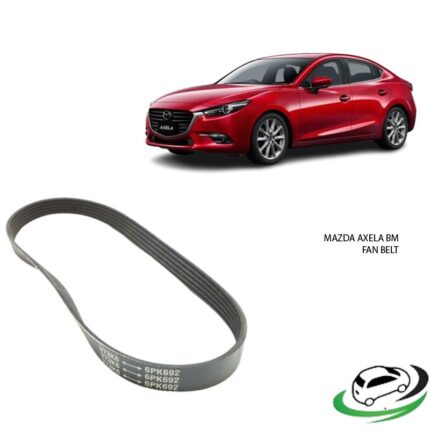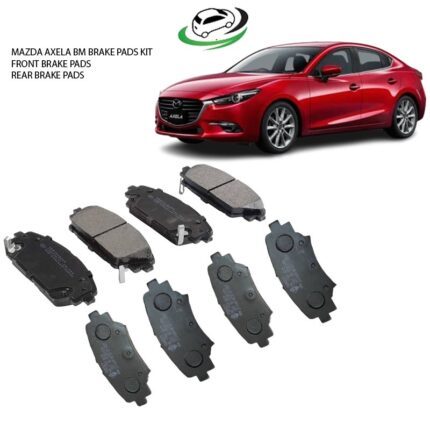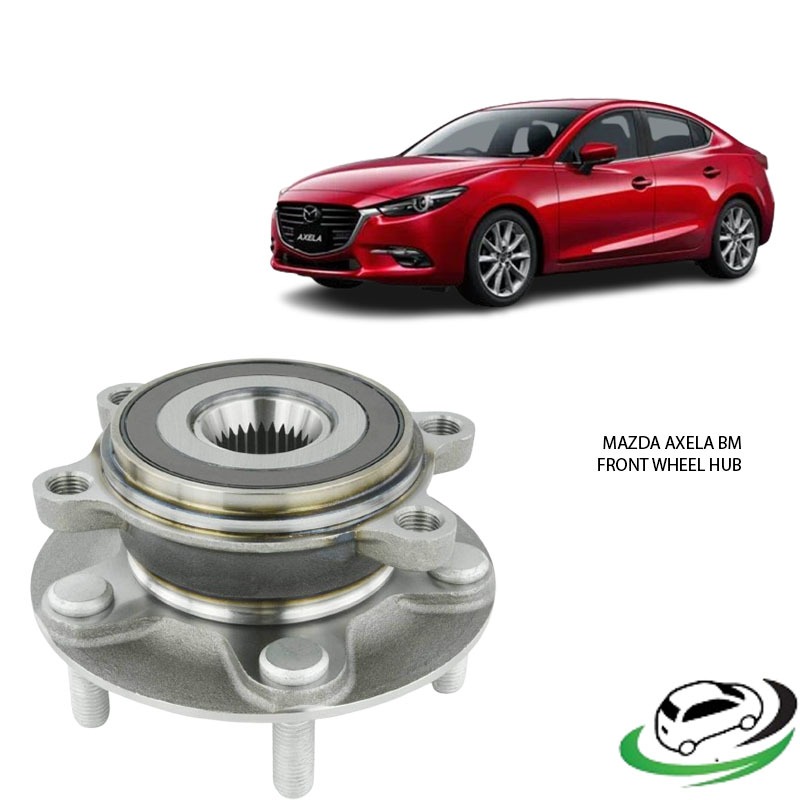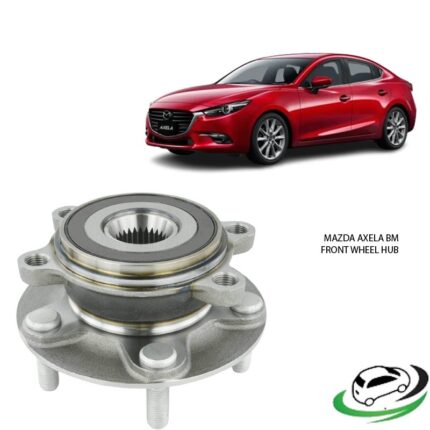Get Mazda Axela BM Wheel Hub Bearing B45A-33-04X
The wheel hub bearing is a critical component in a vehicle’s wheel assembly, allowing the wheel to rotate smoothly while supporting the vehicle’s weight. Found between the axle and the wheel, this bearing is subjected to continuous rotational force and must endure a variety of road conditions. The importance of wheel hub bearings extends to the vehicle’s safety, ride comfort, and overall performance. A failing wheel hub bearing can lead to serious issues like compromised handling, uneven tire wear, and even brake failure.
In this comprehensive guide, we will delve into the function, construction, types, signs of wear, maintenance, and replacement of wheel hub bearings.
Function of Wheel Hub Bearings
The wheel hub bearing facilitates smooth rotation of the wheel while supporting the vehicle’s weight. More specifically, its functions include:
- Wheel Rotation:
- Wheel hub bearings enable the wheel to rotate with minimal friction. This is crucial for a vehicle’s performance, fuel efficiency, and maneuverability. Without a proper bearing, the wheel would not spin freely, causing resistance, excessive heat, and potential failure.
- Load Bearing:
- Wheel hub bearings are designed to handle both radial and axial loads. Radial loads are the forces exerted perpendicular to the axle, caused by the vehicle’s weight and road conditions. Axial loads are thrust forces that run parallel to the axle, such as cornering forces during turns.
- Absorbing Shocks:
- The wheel hub bearing also absorbs the shocks from driving over uneven roads or bumps. It helps maintain ride comfort and prevents vibrations from reaching the suspension or chassis.
- Reducing Friction:
- By allowing the wheel to spin with minimal resistance, the wheel hub bearing helps to reduce friction, which not only enhances fuel efficiency but also prevents heat buildup. Excessive friction could lead to premature wear of components like tires, suspension, and brakes.
- Assisting with Alignment and Stability:
- Properly functioning wheel hub bearings help to maintain alignment and stability. They ensure that the wheel remains correctly positioned on the vehicle’s axle, preventing wobbling or uneven movement that can degrade handling performance.
Construction of Wheel Hub Bearings
Wheel hub bearings are engineered to endure extreme conditions, including heavy loads, high speeds, and exposure to dirt and moisture. To meet these challenges, they are made up of several key components:
- Outer and Inner Race (Rings):
- The bearing’s races are hardened steel rings that house the rolling elements. The outer race is fixed to the wheel hub, while the inner race is attached to the axle or spindle. The rolling elements move between these two races, enabling smooth wheel rotation.
- Rolling Elements:
- The rolling elements are typically either ball bearings or tapered roller bearings. Ball bearings are used for lighter loads and higher speeds, whereas tapered roller bearings are designed to handle both radial and axial loads, making them suitable for heavier vehicles and more demanding driving conditions.
- Cage:
- The cage (also known as the retainer) is the component that keeps the rolling elements evenly spaced and prevents them from colliding with each other. This helps to minimize friction and ensures smooth movement within the bearing.
- Seals:
- Wheel hub bearings are sealed to keep out contaminants like water, dirt, and debris. These seals are vital for extending the bearing’s lifespan, as contamination can lead to corrosion, increased friction, and eventual failure.
- Lubrication:
- High-quality grease is packed within the bearing to reduce friction and heat buildup. This lubrication helps to ensure smooth operation and prevents metal-to-metal contact, which could cause the bearing to wear prematurely.
Types of Wheel Hub Bearings
There are several different types of wheel hub bearings, each designed for specific applications and vehicle types:
- Ball Bearings:
- Ball bearings use spherical rolling elements and are one of the most common types. They are typically used in smaller, lighter vehicles where speed is a priority. However, they are not as durable when subjected to heavy loads or high lateral forces.
- Tapered Roller Bearings:
- Tapered roller bearings have cone-shaped rolling elements, which provide better load distribution and can handle both radial and axial forces. These bearings are common in heavier vehicles, such as trucks and SUVs, due to their durability and ability to withstand greater stress.
- Hub Units:
- Modern vehicles often use integrated hub assemblies (hub units) instead of individual bearings. Hub units combine the bearing, hub, and wheel flange into a single assembly. This simplifies installation and ensures precise alignment but makes replacement more costly, as the entire assembly must be replaced if the bearing fails.
- Pre-Greased and Sealed Bearings:
- Many modern wheel hub bearings are pre-greased and sealed for life, meaning they don’t require regular maintenance. These bearings are designed to last the life of the vehicle, but if they fail, they cannot be serviced and must be replaced.
Signs of Worn or Failing Wheel Hub Bearings
Recognizing the signs of a failing wheel hub bearing can help prevent serious safety issues and expensive repairs. Common symptoms of a worn or damaged wheel hub bearing include:
- Grinding or Humming Noise:
- One of the most common indicators of a failing wheel hub bearing is a grinding, humming, or roaring noise coming from the wheel area. The noise typically increases with speed and may get louder during turns. This sound is caused by metal-to-metal contact within the bearing due to worn or damaged rolling elements.
- Wheel Play:
- Excessive play or looseness in the wheel can indicate a worn bearing. You may notice that the wheel wobbles when the vehicle is jacked up, or the steering feels loose. This is a serious issue, as it can affect the vehicle’s stability and handling.
- Uneven Tire Wear:
- A failing wheel hub bearing can cause uneven tire wear, as the wheel may not rotate smoothly or stay properly aligned. If you notice that one tire is wearing down faster than the others, it could be a sign of a bad bearing.
- Vibration in the Steering Wheel:
- If the wheel hub bearing is worn, you may feel vibrations through the steering wheel. This is often more noticeable at higher speeds or when turning. Vibrations can also be caused by other issues, so it’s important to have the vehicle inspected by a professional.
- ABS Light:
- Many modern vehicles have wheel hub bearings with integrated ABS sensors. If the bearing fails, it can trigger the ABS warning light on the dashboard. This could indicate a problem with the bearing’s sensor or the bearing itself.
Maintenance of Wheel Hub Bearings
While many modern wheel hub bearings are sealed and don’t require maintenance, older vehicles or those with serviceable bearings may need periodic care to extend their lifespan.
- Regular Inspections:
- During routine maintenance or tire rotations, it’s a good idea to inspect the wheel hub bearings for signs of wear or damage. Look for any abnormal noises, looseness, or play in the wheel assembly.
- Lubrication:
- For older, serviceable bearings, it’s important to keep them properly lubricated. Periodically packing the bearings with fresh grease can help reduce friction and prevent premature wear. Be sure to use high-quality, wheel-bearing-specific grease.
- Keep Seals Intact:
- Damaged seals can allow contaminants to enter the bearing, leading to corrosion and failure. Make sure the seals remain intact and replace any that are cracked or damaged.
- Replace When Necessary:
- Wheel hub bearings are wear components and will eventually need to be replaced. It’s important not to ignore the signs of a failing bearing, as continuing to drive with a worn bearing can lead to more serious issues, including loss of control.
Replacement of Wheel Hub Bearings
Replacing a wheel hub bearing requires specialized tools and knowledge, so it’s often best left to professionals. However, understanding the process can help you be better informed about the repair.
- Preparation:
- The vehicle should be safely lifted using a jack and supported with jack stands. The wheel, brake caliper, and rotor need to be removed to access the hub assembly.
- Removing the Old Bearing:
- If the vehicle uses a hub unit, the entire assembly will be unbolted and replaced. For serviceable bearings, the old bearing must be pressed out using a hydraulic press or bearing puller.
- Installing the New Bearing:
- The new bearing is pressed into place, or a new hub unit is bolted in. Care must be taken to ensure the bearing is properly seated, and the axle nut must be torqued to the manufacturer’s specifications.
- Reassembly:
- Once the new bearing is installed, the brake rotor, caliper, and wheel are reattached, and the vehicle is lowered back to the ground.
Conclusion
The wheel hub bearing is a crucial component that ensures the smooth operation of a vehicle’s wheels and contributes to overall safety and performance. Understanding how it works, recognizing the signs of wear, and performing regular inspections can help extend the life of your vehicle’s wheel bearings and prevent costly repairs.
Follow us on Facebook for more parts.





Reviews
Clear filtersThere are no reviews yet.